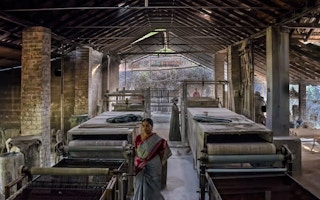The conversion of tropical forests into monoculture plantations has a major effect on non-human primates and plant species. Turning the forests into natural rubber plantations in Tripura is negatively impacting non-human primate species and vegetation in the region, a recent report has found.
The research article, Impact of Monoculture Rubber Plantation on non-Human Primates and Plant Diversity in South Tripura, was co-authored by Prasenjit Patari and Sabyasachi Dasgupta from the department of forestry and biodiversity at Tripura University. It was published in a book, Biodiversity Of Our Mother Earth.
Humans are overusing the world’s tropical forests, the authors wrote. Every year, about 140,000 square kilometres of forests have been lost, according to a 2020 report by non-profit World Wide Fund for Nature.
“A large proportion of primary forest in India has been converted into monoculture plantations like tea, oil palm, teak and natural rubber,” said Patari. “Rubber plantations have doubled their global base from 1960 to 2000.”
States like Kerala and Tamil Nadu are traditionally rubber-growing regions in India.
However, Tripura, Assam, Manipur, Meghalaya, Karnataka, Andaman and Nicobars Islands, Goa, Maharashtra, Orissa, West Bengal and Andhra Pradesh have non-traditional rubber plantation areas as well, according to Indian Council of Agricultural Research’s Biosafety Portal, 2016.
From 2011 to 2018, 21,529.71 hectares (ha) of primary forest and 127,239 ha of tree cover were lost in India, according to Deforestation Statistics for India, 1995-2020, the report cited.
“
A large proportion of primary forest in India has been converted into monoculture plantations like tea, oil palm, teak and natural rubber. Rubber plantations have doubled their global base from 1960 to 2000.
Prasenjit Patari, researcher, Tripura University
In 2020, the worldwide planted area of rubber was 14,878.1 thousand ha, out of them 822,000 ha of which was in India, according to a research portal Statista’s 2021 report, the paper further said.
Culturing natural rubber in the last century has brought significant economic benefits for growers. But excessive rubber plantations are adversely affecting various wildlife and plant species, the report said.
Tripura had 74,335 ha of rubber plantation in 2015-16, according to the central government’s Rubber Board Ministry of Commerce and Industry, it added.
Rubber plantations have replaced a large forest area of Tripura in a short period. However, there is very little information about the direct and indirect effects of such changes on the primate population and floral diversity, the authors said.
The authors conducted sampling programmes in south Tripura district to compare primate species diversity, the number of individual primate species observed and plant species diversity in the forest and nearby monoculture rubber plantations.
The number of monkeys in the rubber plantation area is much lower than in the nearby forests and the primates spend less time in rubber plantations, the researchers found.
Due to the reduction in forest cover, monkeys occasionally enter rubber plantations for food, but they find little in monoculture plantation areas. As a result, monkeys are suffering, their behaviour is changing and species diversity is decreasing.
Non-human primates are of central importance to tropical biodiversity and various ecosystem functions. They are humans’ nearest biological relatives and play a significant role in many societies’ livelihoods, cultures and religions, the paper said.
These primates help in the pollination, seed dispersion and seed germination of many plants and they are essential seed predators in some ecosystems.
But due to the growing rubber plantations, they do not get enough food, which makes their survival difficult. This threatens the species and the primates can go extinct, disrupting the environment’s natural state, the paper warned.
Fewer shrubs and herbaceous plants grow in rubber plantation areas than in the forests as people cut and destroy these plants, the researchers said. This has decreased the biodiversity value of the plantations.
Many wild animals and plants are slowly disappearing in the state as more and more forest land is being converted into plantations for financial gains. However, the impact of these decisions will be faced by future generations, the researchers cautioned.
The research paper also highlighted shrubs and herbaceous plants’ vegetation composition and biodiversity in rubber plantations and forest areas.
The solution is building eco-friendly rubber plantations. The authors suggested growing fruiting plants in rubber plantation areas, maintaining specified distance, so animals are more attracted to them.
Various plants should also be kept intact at the edges of the rubber plantation and around the water bodies, which provide shelter or food habitat for many animals in these areas, the report said.
The agroforestry system allows rubber plants, forest vegetation, edible and useful plants planted together and kept at proper intervals, which is economically suitable and also will help conserve biodiversity.
This story was originally published on Down to Earth.










